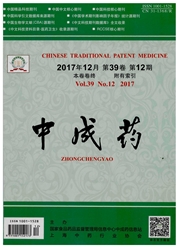

 中文摘要:
中文摘要:
目的探讨水溶性蜂胶联合阿司匹林对大鼠炎性痛作用效应及其可能机制。方法将弗氏完全佐剂造模成功的36只炎性痛大鼠随机均分成6组,炎性痛模型组(模型组)和5个处理组(水溶性蜂胶组,阿司匹林组,水溶性蜂胶+阿司匹林组,水溶性蜂胶+纳洛酮组,水溶性蜂胶+N-硝基-L-精氨酸甲酯(L-NAME)组。随机选取6只大鼠为正常对照组(对照组)。测定各组大鼠的热痛阈潜伏期和机械痛阈值,血清中IL-6、TNF-α及NO的水平,致炎足关节渗出液中PLA2和PGE2的水平。结果与对照组相比,模型组大鼠第1天开始热痛阈潜伏期和机械痛阈值明显降低,热痛觉和机械痛觉过敏持续14 d。模型组大鼠血清中IL-6、TNF-α及NO和渗出液中PLA2和PGE2的水平明显增高。与模型组相比,水溶性蜂胶组、阿司匹林组和水溶性蜂胶+阿司匹林组大鼠热痛阈潜伏期和机械痛阈值均升高,血清中IL-6、TNF-α及NO和渗出液中PLA2和PGE2的水平明显下降。与水溶性蜂胶组相比,水溶性蜂胶+阿司匹林组和水溶性蜂胶+非选择性一氧化氮合酶抑制剂组升高大鼠热痛阈潜伏期和机械痛阈值,而水溶性蜂+纳洛酮组大鼠却明显降低,差异有显著性(P〈0.05,P〈0.01)。结论水溶性蜂胶联合阿司匹林对炎性痛大鼠的抗炎镇痛机制可能是抑制细胞因子及炎性介质的产生而实现的,阿片受体途径可能也发挥一定的作用。
 英文摘要:
英文摘要:
AIM To explore the effects of water soluble propolis (WSP) in combination with aspirin on in- flammatory pain and its possible mechanisms in rats. METHODS Thirty-six male rats with the inflammatory pain successfully induced by feeding freund' s adjuvant (CFA) were randomly and equally divided into six groups, in- cluding inflammatory pain model group ( CFA group) ; CFA + WSP group; CFA + aspirin group; CFA + WSP + as- pirin group ; CFA + WSP + Naloxone group ( NAL group) ; CFA + WSP + L-NAME group, six rats were served as the normal control group (NC group). Each group of rats was measured for the thermal withdrawal latency (TWL) and mechanical withdrawal threshold (MWT). The expressions of IL-6, TNF-~ and NO in serum, and PLA2 and PGE2 in induced inflammatory foot joint effusion of rats were detected. RESULTS The TWL and MWT of rats in the CFA group were significantly lower than those of the NC group from the first day, their thermal and mechanical hyperalgia continued for fourteen days ; The expressions of IL-6, TNF-ct and NO in serum, and PLA2 and PGE2 in induced inflammatory foot joint effusion of rats significantly increased in the CFA group. The TWL and MWT of CFA + WSP, CFA + aspirin and CFA + WSP + aspirin groups were significantly higher than those of the CFA group, while the positive expression levels of 1L-6, TNF-ct and NO in serum, and PEA2 and PGE2 in induced inflammatory foot joint effusion were significantly lower than those of the CFA group. The TWL and MWT of CFA + WSP + aspi- rin and CFA + WSP + L-NAME groups were higher than those of the CFA + WSP group, while the TWL and MWT of CFA + WSP + NAL group were lower than those of the CFA + WSP group, the differences were significant (P 〈 0. 05 or P 〈 0. 01 ). CONCLUSION A good anti-inflammatory and analgesic effect of WSP combined with aspirin may be related to the inhibition of the production of cytokines and inflammatory mediators. Opioid receptor may also olav a key rol
 同期刊论文项目
同期刊论文项目
 同项目期刊论文
同项目期刊论文
 Morphologic features of Sancassania berlesei (Acari: Astigmata: Acaridae), a common mite of stored p
Morphologic features of Sancassania berlesei (Acari: Astigmata: Acaridae), a common mite of stored p Genetic diversity and differentiation of Lepidoglyphus destructor (Acari: Glycyphagidae) inferred fr
Genetic diversity and differentiation of Lepidoglyphus destructor (Acari: Glycyphagidae) inferred fr Production of a chimeric allergen derived from the major allergen group 1 of house dust mite species
Production of a chimeric allergen derived from the major allergen group 1 of house dust mite species 期刊信息
期刊信息
